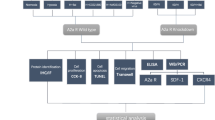Abstract
Objective
To investigate the inhibitory effect of Yifei Huoxue Granule (益肺活血颗粒, YFHXG): on the hypoxia-induced proliferation of rat pulmonary artery smooth muscle cells (PASMCs) and its mechanism of decreasing pulmonary arterial pressure.
Methods
Twenty male Sprague-Dawley (SD) rats were randomly: divided into four groups: saline, and 0.66, 3.30 and 16.50 g/kg of YFHXG groups, the saline and different concentrations of YFHXG were given twice daily for 7 days, respectively. Serum-pharmacology method was used in the preparation of YFHXG serum. Tissue block anchorage was employed in the primary culture of rat PASMCs. The PASMCs were randomly divided into normoxia group, hypoxia group, and hypoxia+YFHXG group (0.66, 3.30 and 16.50 g/kg doses of YFHXG-treated serum groups, exposed to hypoxic condition). PASMCs in normoxia and hypoxia group were cultured with saline serum, hypoxia+YFHXG groups were cultured with different concentrations of YFHXG serum. Cell viability was assessed with 3-(4,5-dimethylthiazol-2-yl)-2,5-diphenyltetrazolium bromide (MTT) assay. Cell cycle was analyzed using flow cytometry. In addition, hypoxia inducible factor-1-alpha (HIF-1α) protein expression was evaluated by immunocytochemistry analysis, the concentration of intracellular reactive oxygen species (ROS) and Ca Ca2+ were determined by laser scanning confocal microscopy (LSCM).
Results
MTT assay and flow cytometry showed that hypoxia could directly activate the proliferation of PASMCs, while YFHXG dose-dependently inhibited hypoxia-induced proliferation of rat PASMCs. Immunocytochemistry showed that hypoxia enhanced HIF-1α protein expression, and LSCM showed that hypoxia significantly increased intracellular ROS and Ca Ca2+, while YFHXG decreased the expression of HIF-, 1α and attenuated the hypoxia-induced increase in intracellular concentration of ROS and Ca Ca2+.
Conclusions
YFHXG could inhibit hypoxia-induced proliferation of rat PASMCs, which may decrease pulmonary arterial pressure and vascular remodeling. The anti-hypoxia effect of YFHXG may be explained by its regulation of HIF-1α expression and of the levels of intracellular ROS and Ca Ca2+.
Similar content being viewed by others
References
Semenza GL. Involvement of hypoxia-inducible factor 1 in pulmonary pathophysiology. Chest 2005;128:592–594.
Rathore R, Zheng YM, Li XQ, Wang QS, Liu QH, Ginnan R, et al. Mitochondrial ROS-PKCɛ signaling axis is uniquely involved in hypoxic increase in [Ca2+] in pulmonary artery smooth muscle cells. Biochem Biophys Res Commun 2006;351:784–790.
Rathore R, Zheng YM, Niu CF, Liu QH, Korde A, Ho YS, et al. Hypoxia activates NADPH oxidase to increase [ROS] i and [Ca2+]i through the mitochondrial ROS-PKC signaling axis in pulmonary artery smooth muscle cells. Free Radic Biol Med 2008;45:1223–1231.
Bonnet S, Michelakis ED, Porter CJ, Andrade-Navarro MA, Thebaud B, Bonnet S, et al. An abnormal mitochondrialhypoxia inducible factor-1alpha-Kv channel pathway disrupts oxygen sensing and triggers pulmonary arterial hypertension in fawn hooded rats: similarities to human pulmonary arterial hypertension. Circulation 2006;113:2630–2641.
Perez-Vizcaino F, Cogolludo A, Moreno L. Reactive oxygen species signaling in pulmonary vascular smooth muscle. Respir Physiol Neurobiol 2010;174:212–220.
Nelson MT, Quayle JM. Physiological roles and properties of potassium channels in arterial smooth muscle. Am J Physiol 1995;268:C799–C822.
Platoshyn O, Golovina VA, Bailey CL, Limsuwan A, Krick S, Juhaszova M, et al. Sustained membrane depolarization and pulmonary artery smooth muscle cell proliferation. Am J Physiol Cell Physiol 2000;279:C1540–C1549.
Zhai HQ, He S, Yuan Y, Sheng YH, Ou M. Influence of Yifei Huoxue Granule (YFHXG) on pulmonary artery pressure in the chronic pulmonary heart disease in rabbits evaluated by color doppler flow imaging. Chin J Exp Tradit Med Formul (Chin) 2010;9:132–134.
Zhai HQ, Yuan Y, Ou M, Zhen HZ. Effect of Yifei Huoxue granule(YFHXG) on the pathological morphous of pulmonary vascular injury in rabbits. Chin J Pathophysiol (Chin) 2010;3:590–592.
Yuan XJ, Goldman WF, Tod ML, Rubin LJ, Blaustein MP. Ionic currents in rat pulmonary and mesenteric arterial myocytes in primary culture and subculture. Am J Physiol 1993;264:L107–L115.
Semenza GL, Roth PH, Fang HM, Wang GL. Transcriptional regulation of genes encoding glycolytic enzymes by hypoxiainducible factor 1. J Biol Chem 1994;269:23757–23763.
Carmeliet P, Dor Y, Herbert JM, Fukumura D, Brusselmans K, Dewerchin M, et al. Role of HIF-1 alpha in hypoxiamediated apoptosis, cell proliferation and tumour angiogenesis. Nature 1998;394:485–490.
Lacombe C, Mayeux P. Biology of erythropoietin. Haematol 1998;83:724–732.
Rose F, Grimminger F, Appel J, Heller M, Pies V, Weissmann N, et al. Hypoxic pulmonary artery fibroblasts trigger proliferation of vascular smooth muscle cells: role of hypoxia-inducible transcription factors. FASEB J 2002;16:1660–1661.
Waypa GB, Schumacker PT. Hypoxic pulmonary vasoconstriction: redox events in oxygen sensing. J Appl Physiol 2005;98:404–414.
Moudgil R, Michelakis ED, Archer SL. Hypoxic pulmonary vasoconstriction. J Appl Physiol 2005;98:390–403.
Waypa GB, Guzy R, Mungai PT, Mack MM, Marks JD, Roe MW, et al. Increases in mitochondrial reactive oxygen species trigger hypoxia-induced calcium responses in pulmonary artery smooth muscle cells. Circ Res 2006;99:970–978.
Waypa GB, Schumacker PT. Oxygen sensing in hypoxic pulmonary vasoconstriction: using new tools to answer an age-old question. Exp Physiol 2008;93:133–138.
Ng LC, Wilson SM, Hume JR. Mobilization of sarcoplasmic reticulum stores by hypoxia leads to consequent activation of capacitative Ca2+ entry in isolated canine pulmonary arterial smooth muscle cells. J Physiol 2005;563:409–419.
Zheng YM, Wang QS, Rathore R, Zhang WH, Mazurkiewicz JE, Sorrentino V, et al. Type-3 ryanodine receptors mediate hypoxia, but not neurotransmitter-induced calcium release and contraction in pulmonary artery smooth muscle cells. J Gen Physiol 2005;125:427–440.
Dipp M, Nye PC, Evans AM. Hypoxic release of calcium from the sarcoplasmic reticulum of pulmonary artery smooth muscle. Am J Physiol Lung Cell Mol Physiol 2001;281:L318–L325.
Author information
Authors and Affiliations
Corresponding author
Additional information
Supported by Military Medical and Health Foundation (No. 36040)
Rights and permissions
About this article
Cite this article
Zhang, Ly., Ou, M., Huang, Yz. et al. Effect of Yifei Huoxue Granule (益肺活血颗粒) on the proliferation of rat pulmonary artery smooth muscle cells upon exposure to chronic hypoxic conditions in vitro . Chin. J. Integr. Med. 18, 507–513 (2012). https://doi.org/10.1007/s11655-012-1150-7
Received:
Published:
Issue Date:
DOI: https://doi.org/10.1007/s11655-012-1150-7




